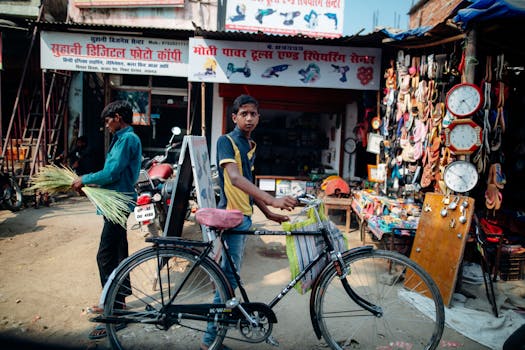
**
India's Kirana Stores Fight Back: Adapting to the Quick Commerce Revolution
India's retail landscape is undergoing a seismic shift. The meteoric rise of quick commerce, fueled by apps offering grocery delivery in minutes, has presented both a challenge and an opportunity for the nation's ubiquitous kirana stores – the small, independent neighborhood shops that form the backbone of the country's retail infrastructure. While initially threatened by the speed and convenience of online giants, savvy kirana owners are now reinventing themselves, leveraging technology and adapting their business models to not only survive but thrive in this new era. This evolution highlights the resilience and adaptability of India's traditional retail sector and the ongoing battle for market share in the burgeoning Indian quick commerce market.
The Quick Commerce Tsunami: A Threat and an Opportunity
The quick commerce (q-commerce) boom, driven by apps like Blinkit, Dunzo, and Swiggy Instamart, has dramatically altered consumer expectations. Customers are increasingly demanding instant gratification, expecting groceries delivered to their doorstep within minutes. This has put immense pressure on traditional kirana stores, which historically relied on a slower, more personal approach to customer service.
However, the threat also presents a significant opportunity. Rather than being replaced, many kirana stores are strategically integrating with q-commerce platforms or adopting their own tech-driven solutions to compete. This dual approach is proving effective in maintaining market share and customer loyalty.
Kirana 2.0: Embracing Technology for Survival
The transformation of kirana stores is evident in several key areas:
1. Leveraging Technology for Inventory Management and Ordering:
- Inventory Management Systems: Many kirana owners are adopting digital inventory management systems to track stock levels, predict demand, and optimize ordering from wholesalers. This reduces waste and ensures they always have the popular items in stock, mirroring the efficiency of large online retailers.
- Online Ordering and Payment: Several platforms are helping kirana stores establish an online presence, allowing customers to place orders via WhatsApp or dedicated apps. The integration of digital payment gateways like PhonePe, Google Pay, and Paytm further streamlines the process, appealing to tech-savvy customers.
- Data Analytics: The data generated from online orders provides valuable insights into customer preferences, enabling kirana owners to tailor their offerings and promotions accordingly. This data-driven approach is essential for staying competitive in a dynamic market.
2. Strategic Partnerships with Quick Commerce Players:
- Dark Stores and Fulfillment Centers: Some kirana stores are partnering with q-commerce companies, acting as mini-fulfillment centers or supplying goods to their dark stores (warehouses optimized for quick delivery). This allows them to tap into the vast reach and delivery networks of these platforms while retaining their local customer base.
- Hyperlocal Delivery Networks: Others are creating their own hyperlocal delivery networks, using bicycles or motorcycles to compete directly with larger players on speed and convenience. This approach capitalizes on the kirana store's inherent advantage: proximity to customers.
3. Enhancing Customer Experience:
- Personalized Service: While speed is crucial in q-commerce, many customers still value the personal touch provided by their local kirana store. Maintaining friendly relationships and offering personalized recommendations remains a key differentiator.
- Loyalty Programs and Promotions: Kirana stores are increasingly introducing loyalty programs and running targeted promotions to incentivize repeat business and compete with online discounts.
- Expanding Product Offerings: Some kirana stores are broadening their product range to include more specialized items or ready-to-eat meals, catering to changing consumer needs and preferences.
Challenges Remain: Bridging the Digital Divide
Despite the impressive adaptations, kirana stores face significant hurdles:
- Digital Literacy: Not all kirana owners are tech-savvy, requiring training and support to effectively utilize new technologies.
- Infrastructure Limitations: Reliable internet connectivity and efficient logistics remain challenges in many parts of India, hindering the seamless adoption of digital solutions.
- Competition from Established Players: Competing with well-funded q-commerce giants with vast resources and sophisticated technology requires significant investment and strategic planning.
The Future of Kiranas in the Quick Commerce Era
The survival and success of kirana stores in India's quick commerce revolution hinges on their ability to embrace technology, build strategic partnerships, and enhance the customer experience. The ongoing digital transformation is not about replacing these vital community hubs, but rather empowering them to thrive in a rapidly evolving market. The rise of kirana 2.0 showcases the resilience and adaptability of traditional businesses in the face of disruption, highlighting the ongoing dynamic interplay between established retail models and the innovations of the digital age. The future is likely to be one of collaboration, with kirana stores leveraging technology and partnerships to retain their integral role in India's vibrant retail ecosystem. The ongoing evolution is a testament to the ingenuity of Indian entrepreneurs and their commitment to serving their local communities. The success stories of adapting kirana stores serve as a powerful case study for businesses worldwide grappling with the disruptive forces of the digital economy. The long-term impact will undoubtedly reshape the landscape of grocery retail in India, promising a future where both online and offline retail models coexist and complement each other.




















